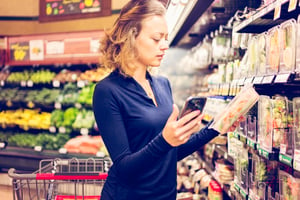 Today’s consumer has more power than ever before, and with information literally at their fingertips in the form of smartphones, tablets and computers, in today’s digital age the consumer is more informed than ever.
Today’s consumer has more power than ever before, and with information literally at their fingertips in the form of smartphones, tablets and computers, in today’s digital age the consumer is more informed than ever.
So naturally, when it comes time to make a purchase, consumers come to store armed with this information - and sometimes misinformation - and through this process begin to make decisions regarding which brands, products, or materials they feel align with their values - and which ones don't - ultimately effecting their buying decisions when faced with the many options on our grocery store shelves.
Regardless of whether their perception is true or false, consumer perception has the power to effect real change. Consumers are beginning to see their purchasing decisions as a form of activism, joining together to ban certain items that are perceived as environmentally unfriendly, such as straws and plastic bags, or in the case of polystyrene and Proposition 65, perceived as harmful to their health.
To answer this, brands are stepping up - pledging to transition plastic packaging to fully recyclable or reusable solutions by 2025, and to polymer replacement initiatives in accordance with Propositions 65 guidelines by 2025. As a result, on the materials side there has been a shift towards embracing redesign and innovation for healthier and more environmentally friendly alternatives leading to initiatives for material replacement and structure redesign, with an eye toward mono-material recyclability (RIC #5 vs #7) and the circular economy – so redesigning with end-of-life in mind.
In addition to the demand for more sustainable and health-conscious packaging solutions, convenience still remains a priority - consumers do not want to give up the convenience that current products provide. In fact, shopping for on-the-go food items is continuing to increase – with consumers shopping for on-the-go solutions for multiple meals and snacks throughout the day. This as a result continues to grow demand for shelf-stable and refrigerated extended shelf-life packaging that can meet all of the requirements of convenience, healthfulness and sustainability.
If you're reading this and you are in the industry, you understand what a massive undertaking this can and will be to find a better solution that checks all the boxes in terms of processing, function, convenience and sustainability. But what if you could maintain all of the positive attributes of today’s single serve and shelf-stable barrier packaging - processing, barrier protection, convenience, quality, cost. What if all of that could be maintained, but new formulations and new technologies could work to change consumer perception? What if converting current to “better” could yield an actual sustainable recycling stream, with real value to the recycler? What if, without changing design or sacrificing benefits, without replacing billions of dollars in consumer and processor owned systems you could reduce plastic by weight by 12%, removing billions of pounds of plastic from the annual equation?
With ICPG’s XPP™ enhanced barrier technology, we can now offer simplified barrier polypropylene structures with barrier enhancements of up to 90%/90% OTR/MVTR vs traditional PP and 100%/150% OTR/MVTR vs traditional PS, as well as added clarity and low haze compared to traditional polypropylene materials. This material also offers enhanced stiffness to meet or exceed polystyrene standards for snapability, allowing for replacement of PS in form-fill-seal applications, as well as offering potential down-gauging and light-weighting opportunities for existing structures.
Our enhanced barrier PP solutions offer benefits including:
-
- Structure simplification
- Enhanced barrier properties
- Mechanical improvements
- High heat tolerance
- Compatibility with thermoforming & FFS
- Improved recycling attributes
- Improved sustainability metrics
- Re-integration for a closed-loop circular economy solution
Sound like the answer to all of your problems? Check it out for yourself:




